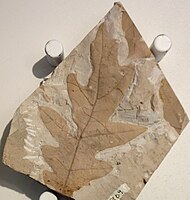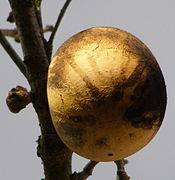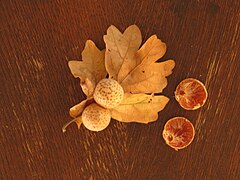Oak
| Oak | |
|---|---|
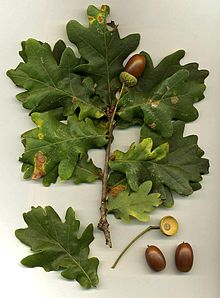
| |
| Foliage and acorns of Quercus robur | |
| Scientific classification | |
| Kingdom: | Plantae |
| Clade: | Tracheophytes |
| Clade: | Angiosperms |
| Clade: | Eudicots |
| Clade: | Rosids |
| Order: | Fagales |
| Family: | Fagaceae |
| Subfamily: | Quercoideae |
| Genus: | Quercus L. |
| Subgenera and sections | |
|
See also List of Quercus species. | |
An oak is a
Ecologically, oaks are
In culture, the oak tree is a symbol of strength and serves as the
Etymology
The
Description
Oaks are
Trees in the genus are often large and slow-growing; Q. alba can reach an age of 600 years, a diameter of 13 feet (4.0 m) and a height of 145 feet (44 m).[8] The Granit oak in Bulgaria, a Q. robur specimen, has an estimated age of 1637 years, making it the oldest oak in Europe.[9] The Wi'aaSal tree, a live oak in the reservation of the Pechanga Band of Indians, California, is at least 1000 years old, and might be as much as 2000 years old, which would make it the oldest oak in the US.[10] Among the smallest oaks is Q. acuta, the Japanese evergreen oak. It forms a bush or small tree to a height of some 30 feet (9.1 m).[11]
-
Quercus robur habit
-
Illustration of Quercus lusitanica showing staminate (left) and pistillate flowers, which mature into acorns (right)
-
Catkins of Quercus alba containing the staminate or 'male' flowers
-
New leaves and reddish pistillate or 'female' flowers of Quercus robur
Distribution
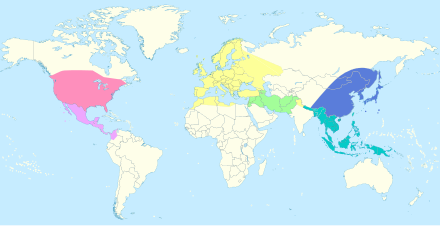
The genus Quercus is native to the Northern Hemisphere and includes
In the Americas, Quercus is widespread from Vancouver and Nova Scotia in the south of Canada, south to Mexico and across the whole of the eastern United States. It is present in a small area of the west of Cuba; in Mesoamerica it occurs mainly above 1000 metres.[14] The genus crossed the isthmus of Panama when the northern and southern continents came together[15] and is present as one species, Q. humboldtii, above 1000 metres in Colombia.[14] The oaks of North America are of many sections (Protobalanus, Lobatae, Ponticae, Quercus, and Virentes) along with related genera such as Notholithocarpus.[12]
In the Old World, oaks of section Quercus extend across the whole of Europe including European Russia apart from the far north, and north Africa (north of the Sahara) from Morocco to Libya. In Mediterranean Europe, they are joined by oaks of the sections Cerris and Ilex, which extend across Turkey, the Middle East, Iran, Afghanistan and Pakistan, while section Ponticae is endemic to the western Caucasus in Turkey and Georgia. Oaks of section Cyclobalanopsis extend in a narrow belt along the Himalayas to cover mainland and island Southeast Asia as far as Sumatra, Java, Borneo, and Palawan.[7][16] Finally, oaks of multiple sections (Cyclobalanopsis, Ilex, Cerris, Quercus and related genera like Lithocarpus and Castanopsis) extend across east Asia including China, Korea, and Japan.[12]
Evolution
Fossil history
Potential records of Quercus have been reported from
-
Quercus hiholensis acorn, Langhian age (Middle Miocene), Washington State, USA (c. 15 mya)
-
Quercus kobatakei leaf. Early Oligocene, Japan
-
Early Oligocene acorn, Oregon, USA (33 mya)
External phylogeny
Quercus forms part, or rather two parts, of the Quercoideae subfamily of the Fagaceae, the beech family. Modern molecular phylogenetics suggests the following relationships:[18][19]
| Fagaceae |
| ||||||||||||||||||||||||||||||||||||||||||||||||
Internal phylogeny
Molecular techniques for phylogenetic analysis show that the genus Quercus consisted of
| Quercus | |
| 56 mya
|
Taxonomy
Taxonomic history
The genus Quercus was
A 2017 classification of Quercus, based on multiple molecular phylogenetic studies, divided the genus into two subgenera and eight sections:[29]
- Subgenus Quercus – the New World clade (or high-latitude clade), mostly native to North America
- Section Lobatae Loudon – North American red oaks
- Section Protobalanus (Trelease) O.Schwarz – North American intermediate oaks
- Section Ponticae Stef. – with a disjunct distribution between western Eurasia and western North America
- Section Virentes Loudon – American southern live oaks
- Section Quercus – white oaks from North America and Eurasia
- Subgenus Cerris Oerst. – the Old World clade (or mid-latitude clade), exclusively native to Eurasia
- Section Cyclobalanopsis Oerst. – cycle-cup oaks of East Asia
- Section Cerris Dumort. – cerris oaks of subtropical and temperate Eurasia and North Africa
- Section Ilex Loudon – ilex oaks of tropical and subtropical Eurasia and North Africa
The subgenus division supports the evolutionary diversification of oaks among two distinct clades: the Old World clade (subgenus Cerris), including oaks that diversified in Eurasia; and the New World clade (subgenus Quercus), oaks that diversified mainly in the Americas.[20][30]
Subgenus Quercus
- Sect. Lobatae (Styles are long; the acorns mature in 18 months and taste very bitter. The inside of the acorn shell appears woolly. The actual nut is encased in a thin, clinging, papery skin. The leaves typically have sharp lobe tips, with spiny bristles at the lobe.[29]
- Sect. Protobalanus, the canyon live oak and its relatives, in the southwestern United States and northwest Mexico. Styles are short; the acorns mature in 18 months and taste very bitter. The inside of the acorn shell appears woolly. The leaves typically have sharp lobe tips, with bristles at the lobe tip.[29]
- Sect. Ponticae, a disjunct including just two species. Styles are short, and the acorns mature in 12 months. The leaves have large stipules, high secondary veins, and are highly toothed.[29]
- Sect. Virentes, the southern live oaks of the Americas. Styles are short, and the acorns mature in 12 months. The leaves are evergreen or subevergreen.[29]
- Sect. Quercus (synonyms Lepidobalanus and Leucobalanus), the white oaks of Europe, Asia and North America. Trees or shrubs that produce nuts, specifically acorns, as fruits. Acorns mature in one year for annual trees and two years for biannual trees. Acorn is encapsulated by a spiny cupule as characterized by the family Fagaceae. Flowers in the Quercus genera produce one flower per node, with three or six styles, as well as three or six ovaries, respectively. The leaves mostly lack a bristle on their lobe tips, which are usually rounded. The type species is Quercus robur.[29][31]
Subgenus Cerris
The type species is Quercus cerris.
- Sect. Cyclobalanopsis, the ring-cupped oaks of eastern and southeastern Asia. These are evergreen trees growing 10–40 metres (33–131 feet) tall. They are distinct from subgenus Quercus in that they have acorns with distinctive cups bearing concrescent rings of scales; they commonly also have densely clustered acorns, though this does not apply to all of the species. Species of Cyclobalanopsis are common in the evergreen subtropical laurel forests, which extend from southern Japan, southern Korea, and Taiwan across southern China and northern Indochina to the eastern Himalayas, in association with trees of the genus Castanopsis and the laurel family (Lauraceae).[29]
- Sect. Cerris, the Turkey oak and its relatives of Europe and Asia. Styles are long; acorns mature in 18 months and taste very bitter. The inside of the acorn's shell is hairless. Its leaves typically have sharp lobe tips, with bristles at the lobe tip.[29]
- Sect. Ilex, the Ilex oak and its relatives of Eurasia and northern Africa. Styles are medium-long; acorns mature in 12–24 months, appearing hairy on the inside. The leaves are evergreen, with bristle-like extensions on the teeth.[29]
Ecology
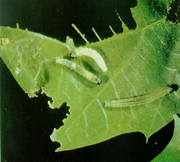
Oaks are keystone species in a wide range of habitats from Mediterranean semi-desert to subtropical rainforest. They are important components of hardwood forests; some species grow in associations with members of the Ericaceae in oak–heath forests.[32][33] Several kinds of truffles, including two well-known varieties – black Périgord truffle[34] and the white Piedmont truffle[35] – have symbiotic relationships with oak trees. Similarly, many other fungi, such as Ramaria flavosaponaria, associate with oaks.[36][37]
Oaks support more than 950 species of caterpillars, an important food source for many birds.[38] Mature oak trees shed widely varying numbers of acorns (known collectively as mast) annually, with large quantities in mast years. This may be a predator satiation strategy, increasing the chance that some acorns will survive to germination.[39]
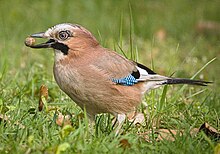
Animals including squirrels[40] and jays – Eurasian jays in the Old World, blue jays in North America – feed on acorns, and are important agents of seed dispersal as they carry the acorns away and bury many of them as food stores.[41][42][43] However, some species of squirrel selectively excise the embryos from the acorns that they store, meaning that the food store lasts longer and that the acorns will never germinate.[40]
Hybridisation
Frequent hybridization among oaks has consequences for oak populations around the world; most notably, hybridization has produced large populations of hybrids with much introgression and the evolution of new species.[47] Introgression has caused different species in the same populations to share up to 50% of their genetic information.[48] As a result, genetic data often does not differentiate between clearly morphologically distinct species, but instead differentiates populations.[49] The maintenance of particular loci for adaptation to ecological niches may explain the retention of species identity despite significant gene flow.[50]
The
Diseases and pests

Oaks are affected by a large number of pests and diseases. For instance, Q. robur and Q. petraea in Britain host 423 insect species.[54] This diversity includes 106 macro-moths, 83 micro-moths, 67 beetles, 53 cynipoidean wasps, 38 heteropteran bugs, 21 auchenorrhynchan bugs, 17 sawflies, and 15 aphids.[54] The insect numbers are seasonal: in spring, chewing insects such as caterpillars become numerous, followed by insects with sucking mouthparts such as aphids, then by leaf miners, and finally by gall wasps such as Neuroterus.[55] Several powdery mildews affect oak species. In Europe, the species Erysiphe alphitoides is the most common.[56] It reduces the ability of leaves to photosynthesize, and infected leaves are shed early.[57] Another significant threat, the oak processionary moth (Thaumetopoea processionea), has emerged in the UK since 2006. The caterpillars of this species defoliate the trees and are hazardous to human health; their bodies are covered with poisonous hairs which can cause rashes and respiratory problems.[58] A little-understood disease of mature oaks, acute oak decline, has affected the UK since 2009.[59] In California, goldspotted oak borer (Agrilus auroguttatus) has destroyed many oak trees,[60] while sudden oak death, caused by the oomycete pathogen Phytophthora ramorum, has devastated oaks in California and Oregon, and is present in Europe.[61] Japanese oak wilt, caused by the fungus Raffaelea quercivora, has rapidly killed trees across Japan.[62]
Gall communities
Many
-
Oak apple gall on Quercus garryana
-
Oak apples on oak leaf
-
Biorhiza pallida male, the cause of oak apple galls
Toxicity
The leaves and acorns of oaks are poisonous to
Uses
Timber
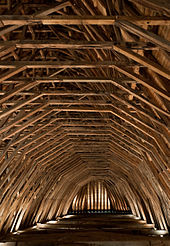
Oak timber is a strong and hard wood with many uses, such as for furniture, floors, building frames, and veneers.[70] The wood of a red oak The wood is resistant to insect and fungal attack.[74]
Wood from Q. robur and Q. petraea was used in Europe for
Other traditional products
Culinary
-
oak barrels
-
A cross section of the trunk of acork oak, Quercus suber, showing the thick spongy bark used for making wine bottle corks
Conservation
An estimated 31% of the world's oak species are threatened with extinction, while 41% of oak species are considered to be of conservation concern. The countries with the highest numbers of threatened oak species (as of 2020) are China with 36 species, Mexico with 32 species, Vietnam with 20 species, and the US with 16 species. Leading causes are climate change and invasive pests in the US, and deforestation and urbanization in Asia.[90][91][92] In the Himalayan region of India, oak forests are being invaded by pine trees due to global warming. The associated pine forest species may cross frontiers and integrate into the oak forests.[93] Over the past 200 years, large areas of oak forest in the highlands of Mexico, Central America, and the northern Andes have been cleared for
Culture
Symbols
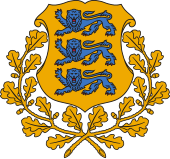
The oak is a widely used symbol of strength and
Religion
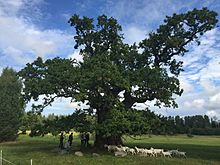
The prehistoric
History
- Category: Individual oak trees
Several oak trees hold cultural importance; such as the
In the Roman Republic, a crown of oak leaves was given to those who had saved the life of a citizen in battle; it was called the "Civic Crown".[112] In his 17th century poem The Garden, Andrew Marvell critiqued the desire to be awarded such a leafy crown: "How vainly men themselves amaze / To win the palm, the oak, or bays; And their uncessant labors see / Crowned from some single herb or tree, ..."[119][120]
Notes
- ^ The New World sections are Protobalanus, Lobatae, Ponticae, Quercus, and Virentes. Old World sections are Cerris, Ilex and Cyclobalanopsis.
- ^ The North American sections are Protobalanus, Lobatae, Ponticae, Quercus, and Virentes.
- ^ The Central American sections are Virentes, Quercus and Lobatae
- ^ The European sections are Quercus, Cerris and Ilex.
- ^ The West/Central Asian sections are Ponticae, Quercus, Cerris and Ilex.
- ^ The Southeast Asian sections are Quercus, Cyclobalanopsis, Cerris and Ilex.
- ^ The East Asian sections are Quercus, Cerris, Ilex and Cyclobalanopsis.
References
- ^ "Quercus (n.)". Online Etymology Dictionary. Retrieved 1 October 2023.
- ISBN 978-0-19-283131-6.
- ^ "Quercus (n.)". Online Etymology Dictionary. Retrieved 1 October 2023.
- ^ Conrad, Jim (12 December 2011). "Oak Flowers". Backyardnature.com. Archived from the original on 4 November 2013.
- ISBN 978-0-2927-8164-1. Archivedfrom the original on 15 February 2017.
- ^ Hipp, Andrew (2004). Oak Trees Inside and Out. Rosen Publishing. p. 4.
- ^ a b "Quercus L." Plants of the World Online. Royal Botanic Gardens, Kew. Retrieved 30 September 2020.
- ^ Core, Earl L. "Silvical Characteristics of the Five Upland Oaks" (PDF). United States Department of Agriculture]]. pp. 19–22. Retrieved 5 October 2023.
- ^ Todorov, Radoslav (30 September 2018). "Знаете ли кои са най-старите живи организми?" [Do you know which are the oldest living organisms?]. Chronicle.B (in Bulgarian). Retrieved 5 October 2023.
- ^ "The Largest Oak Trees in the World". Hardwoods Group. 27 July 2021. Retrieved 5 October 2023.
- ^ Gilman, Edward F.; Watson, Dennis G. "Quercus acuta: Japanese Evergreen Oak". IFAS. Retrieved 5 October 2023.
- ^ S2CID 258428911
- ^ Hogan, C. Michael (2012) "Oak" Archived 23 May 2013 at the Wayback Machine. ed. Arthur Dawson. Encyclopedia of Earth. National Council for Science and the Environment. Washington DC
- ^ a b Nixon, Kevin C. (2006). "Global and neotropical distribution and diversity of oak (genus Quercus) and oak forests". Ecology and conservation of neotropical montane oak forests. Springer. pp. 3–13.
- ^ Hooghiemstra, H. (2006). "Immigration of Oak into Northern South America: A Paleo-Ecological Document". Ecology and conservation of neotropical montane oak forests. Springer. pp. 17–28.
- ^ Jablonski, Eike (2000). "Among the Oaks of Borneo and Java". International Oaks (10, Spring 2000).
- ISBN 978-3-319-69098-8
- S2CID 85671229.
- ISSN 1433-8319.
- ^ S2CID 85925622.
- PMID 28921530.
- S2CID 85604759.
- S2CID 42715997.
- PMID 29915331.
- PMID 31609470.
- ^ Pardo, Francisco M. Vázquez; Maqueda, Soledad Ramos; Pérez, Esperanza Doncel (2002). "Quercus ilex L. and Quercus rotundifolia Lam.: Two Different Species" (PDF). International Oaks (13): 9–14.
- JSTOR taxon.62.5.1041.
- S2CID 43477057.
- ^ ISBN 978-3-319-69099-5.
- ISSN 1999-4907.
- OCLC 1027726223.
- ^ The Natural Communities of Virginia Classification of Ecological Community Groups (Version 2.3), Virginia Department of Conservation and Recreation, 2010 Archived 15 January 2009 at the Wayback Machine. Dcr.virginia.gov. Retrieved 2011-12-10.
- ^ Schafale, M. P. and A. S. Weakley. 1990. Classification of the natural communities of North Carolina: third approximation. North Carolina Natural Heritage Program, North Carolina Division of Parks and Recreation.
- ^ "Truffle Glossary: Black Truffles". thenibble.com. 1 July 2010. Archived from the original on 19 April 2010. Retrieved 1 July 2010.
- ^ "Truffle Glossary: White Truffles". thenibble.com. 1 July 2010. Archived from the original on 25 September 2010. Retrieved 1 July 2010.
- ^ Nirschl, Rick. "Mushrooms of the Oak Openings" (PDF). Toledo Naturalists' Association. p. 4. Archived (PDF) from the original on 9 October 2022. Retrieved 19 July 2018.
- OCLC 7377077277.
- ^ Bryant, Tracey (April 2021). "Planting For the Planet". University of Delaware.
- S2CID 52156639.
- ^ ISSN 2296-701X.
- S2CID 220634002.
- ^ Enroth, Christopher (4 March 2022). "Of blue jays and pin oaks: How jays have shaped our oak forests around the world". University of Illinois Urbana-Champaign. Retrieved 14 October 2023.
- ISSN 0005-7959.
- JSTOR 1219444.
- PMID 11903563.
- ISBN 0-19-509974-5.
- S2CID 83882998.
- S2CID 23587024.
- PMID 16199484.
- ISSN 1916-2790.
- PMID 8405983.
- S2CID 84936653.
- ^ ISBN 0-07-111182-4.
- ^ JSTOR 4528.
- .
- .
- S2CID 21267431.
- ^ unspecified (11 September 2018). "Oak Processionary Moth - Tree pests and diseases". Forestry Commission (UK). Archived from the original on 20 November 2018. Retrieved 31 January 2019.
- ^ Kinver, Mark (28 April 2010). "Oak disease 'threatens landscape'". BBC News. Archived from the original on 29 April 2010. Retrieved 29 April 2010.
- ^ Coleman, T. W. (4 August 2008). "New insect evidence in continuing oak mortality" (PDF). US Forest Service.
- ISSN 1935-9411.
- ^ Kuroda, K.; Yamada, T. (1996). "Discoloration of sapwood and blockage of xylem sap ascent in the trunks of wilting Quercus spp. following attack by Platypus quercivorus". Journal of the Japanese Forestry Society. 78 (1): 84–88.
- PMID 25340198.
- .
- PMID 24917312.
- ^ Cappai, Maria Grazia, et al. "Pigs use endogenous proline to cope with acorn (Quercus pubescens Willd.) combined diets high in hydrolysable tannins." Livestock Science 155.2-3 (2013): 316-322.
- ^ Joffre, R; Rambal, S.; Ratte, J.P. (1999). "The dehesa system of southern Spain and Portugal as a natural ecosystem mimic," Journal of Agroforestry 45(1-3): 57-79.
- JSTOR j.ctv177tk45.
- ^ Bainbridge, D. A. (12–14 November 1986), Use of acorns for food in California: past, present and future, San Luis Obispo, CA.: Symposium on Multiple-use Management of California's Hardwoods, archived from the original on 27 October 2010, retrieved 11 July 2015
- ^ Dotson, J. Dianne (22 November 2019). "What Are Oak Trees Used for?". Sciencing. Retrieved 9 October 2023.
- ^ Merela, Maks, and Katarina Čufar. "Density and mechanical properties of oak sapwood versus heartwood in three different oak species". Drvna industrija 64.4 (2013): 323–334.
- ^ Aldrich, Preston R., et al. "Whole-tree silvic identifications and the microsatellite genetic structure of a red oak species complex in an Indiana old-growth forest." Canadian Journal of Forest Research 33.11 (2003): 2228–2237.
- ^ Nixon, Kevin C. (1997). "Quercus shumardii". In Flora of North America Editorial Committee (ed.). Flora of North America North of Mexico (FNA). Vol. 3. New York and Oxford: Oxford University Press – via eFloras.org, Missouri Botanical Garden, St. Louis, MO & Harvard University Herbaria, Cambridge, MA.
- ^ Thaler, Nejc; Humar, Miha. "Performance of oak, beech and spruce beams after more than 100 years in service". International Biodeterioration & Biodegradation 85 (2013): 305–310.
- OCLC 610026758.
- ^ Kala, C.P. (2004). Studies on the indigenous knowledge, practices, and traditional uses of forest products by human societies in Uttarakhand state of India. GBPIHED, Almora, India
- ISBN 8176222097.
- JSTOR 40273608
- ^ "A History of Ink in Six Objects". History Today.
- sawtooth oak, and cedar, which all have relatively thick bark.
- ^ Henkel, Alice. American medicinal barks. No. 139. US Government Printing Office, 1909.
- ^ Szabłowska, Emilia; Tańska, Małgorzata. "Acorn flour properties depending on the production method and laboratory baking test results: A review." Comprehensive Reviews in Food Science and Food Safety 20.1 (2021): 980-1008.
- S2CID 58542098.
- ^ Piggott, John R.; Conner, John M. "Whiskies." Fermented beverage production. Boston, Massachusetts: Springer, 2003. 239–262.
- ^ Pérez-Prieto, Luis J., et al. "Extraction and formation dynamic of oak-related volatile compounds from different volume barrels to wine and their behavior during bottle storage." Journal of Agricultural and Food Chemistry 51.18 (2003): 5444–5449.
- ^ Perez‐Prieto, Luis Javier, et al. "Oak‐matured wines: influence of the characteristics of the barrel on wine colour and sensory characteristics." Journal of the Science of Food and Agriculture 83.14 (2003): 1445–1450.
- ISSN 0308-8146.
- .
- ^ "Mitos e curiosidades". Amorim. Retrieved 13 February 2021.
- ^ "The Red List of Oaks 2020" (PDF). Global Trees Campaign. Archived from the original (PDF) on 16 July 2021. Retrieved 13 December 2020.
- ^ "One-third of the world's oaks at risk of extinction, according to new BGCI report". Botanic Gardens Conservation International. Retrieved 13 December 2020.
- ^ Carrero, Christina; Jerome, Diana; Beckman, Emily; Byrne, Amy; Coombes, Allen J.; et al. (2020), The Red List of Oaks 2020 (PDF), Lisle, IL: The Morton Arboretum
- ISBN 817993442X.
- ISBN 978-3-540-28908-1.
- ^ Lorimer, C.G. (2003) Editorial: The decline of oak forests Archived 17 March 2014 at the Wayback Machine. American Institute of Biological Sciences.
- JSTOR 1587257.
- ISBN 0716718081.
- ^ Estonian Institute. "National symbols of Estonia". Estonian Institute. Archived from the original on 14 January 2012. Retrieved 4 January 2012.
- PMID 31183874.
- ^ a b "Oak as a Symbol". Venables Oak. Archived from the original on 5 May 2013. Retrieved 26 September 2012.
- ^ "Trees – Arbor Day Foundation". Arborday.org. Archived from the original on 28 April 2010. Retrieved 27 April 2010.
- ^ "Derry". Etymology Online. Retrieved 9 October 2023.
- ^ Schierz, Kai Uwe (2004). "Von Bonifatius bis Beuys, oder: Vom Umgang mit heiligen Eichen". In Hardy Eidam; Marina Moritz; Gerd-Rainer Riedel; Kai-Uwe Schierz (eds.). Bonifatius: Heidenopfer, Christuskreuz, Eichenkult [Boniface: Heathen Sacrifice, Christ's Cross, Oak Cult] (in German). Stadtverwaltung Erfurt. pp. 139–145.
- ^ "Political or Symbolic". Extended Definition: oak. Archived from the original on 30 May 2013. Retrieved 26 September 2012.
- ^ "Army Regulation 670-1 | Wear of appurtenances | Section 29.12 Page 278". ar670.com. Archived from the original on 22 January 2018. Retrieved 19 January 2018.
- ^ Glover, Julian (9 August 2006). "Thatcher's torch extinguished as Cameron's Conservatives carve new logo out of oak". The Guardian. Retrieved 9 October 2023.
- ^ Coalition Government 1989 To 1992. progressivedemocrats.ie
- ^ Frazer, James George (1922). The Golden Bough. Chapter XV: The Worship of the Oak. Archived 21 May 2012 at the Wayback Machine
- ^ Bell, John (1790). Bell's New Pantheon; Or, Historical Dictionary of the Gods, Demi-gods, Heroes, and Fabulous Personages of Antiquity: Also, of the Images and Idols Adored in the Pagan World; Together with Their Temples, Priests, Altars, Oracles, Fasts, Festivals, Games ... J. Bell. pp. 366–7.
- ISBN 951-9078-87-8.
- ^ "Ąžuolas paprastasis". Zolininkas.lt (in Lithuanian). 21 February 2011. Retrieved 10 January 2018.
- ^ ISBN 978-1-1071-7211-1.
- ^ "Fight to save 'sacred' oak from road". BBC. 30 June 2015.
- ^ "Oak mythology and folklore". Trees for Life. Retrieved 29 September 2023.
- ^ "The Legend of the Charter Oak". New England Historical Society. 23 April 2014. Archived from the original on 23 April 2021. Retrieved 23 April 2021.
- ^ unspecified (26 February 2005). "Otro árbol de Gernika". El Mundo.
- ^ Arborecology, containing a photograph of the Millais oak Archived 28 August 2008 at the Wayback Machine. arborecology.co.uk
- ^ Millais, J. G. (1899) Life and Letters of Sir John Everett Millais, vol. 1, p. 166, London : Methuen.
- ^ Marvell, Andrew. "The Garden". Poets.org. Retrieved 29 September 2023.
- JSTOR 23738134.
Hortus, Marvell's Latin poem which seems to be an earlier version of the English one ... both poems begin with the rejection of the worlds of ambitious action, urban life and passionate love, and celebrate a supposed entrance into an entirely new life within the garden.
Further reading
- Byfield, Liz (1990) An Oak Tree, Collins Book Bus, London: Collins Educational, ISBN 0-00-313526-8
- ISBN 0-394-50259-0.
- Logan, William B. (2005) Oak: The Frame of Civilization, New York; London: W. W. Norton, ISBN 0-393-04773-3
- Paterson, R. T. (1993). Use of Trees by Livestock, 5: Quercus, Chatham: Natural Resources Institute, ISBN 0-85954-365-X
- Royston, Angela (2000). Life Cycle of an Oak Tree, Heinemann first library, Oxford: Heinemann Library, ISBN 0-431-08391-6
- Savage, Stephen (1994). Oak Tree, Observing nature series, Hove: Wayland, ISBN 0-7502-1196-2
- OCLC 3196286.
- Żukow-Karczewski, Marek (1988). "Dąb – król polskich drzew" ("Oak – the king of the Polish trees"), AURA: A Monthly for the Protection and Shaping of Human Environment, 9, 20–21.
External links
- Flora of China – Cyclobalanopsis
- Oak diseases
- Flora Europaea: Quercus
- Common Oaks of Florida
- Oaks of the world
- The Global Trees Campaign The Red List of Oaks and Global Survey of Threatened Quercus







